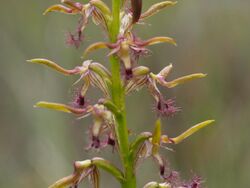Biology:Genoplesium fimbriatum
| Fringed midge orchid | |
|---|---|

| |
| Genoplesium fimbriatum in the Cathedral Rock National Park | |
| Scientific classification | |
| Kingdom: | Plantae |
| Clade: | Tracheophytes |
| Clade: | Angiosperms |
| Clade: | Monocots |
| Order: | Asparagales |
| Family: | Orchidaceae |
| Subfamily: | Orchidoideae |
| Tribe: | Diurideae |
| Genus: | Genoplesium |
| Species: | G. fimbriatum
|
| Binomial name | |
| Genoplesium fimbriatum R.Br. D.L.Jones & M.A.Clem.
| |
| Synonyms[1] | |
| |
Genoplesium fimbriatum, commonly known as the fringed midge orchid is a small terrestrial orchid found from southern Queensland to southern New South Wales. It has a single thin leaf and up to thirty green to brownish-green flowers with red stripes and a red-tipped labellum with hairy edges.
Description
Genoplesium fimbriatum is a terrestrial, perennial, deciduous, herb with an underground tuber and a single thin leaf 200–350 mm (8–10 in) long with the free part 20–30 mm (0.8–1 in) long. Between five and thirty lemon-scented flowers are crowded along a flowering stem 50–100 mm (2–4 in) tall. The flowers are green to brownish-green with red stripes and are 12 mm (0.5 in) long, 9–11 mm (0.35–0.43 in) wide. As with others in the genus, the flowers are inverted so that the labellum is above the column rather than below it. The dorsal sepal is egg-shaped, 4–5 mm (0.16–0.20 in) long, 2–3 mm (0.08–0.1 in) wide with red stripes, a hairy edge and a sharp tip. The lateral sepals are linear to lance-shaped, 5–6 mm (0.20–0.24 in) long, 1–1.5 mm (0.04–0.06 in) wide, free from each other and spread widely apart. The petals are egg-shaped, pointed, about 3 mm (0.1 in) long and 1 mm (0.04 in) wide and striped with long hairs on the edge. The labellum is linear, 4 mm (0.2 in) long, 1 mm (0.04 in) wide with its red tip curled upwards and long pink to red hairs on its edge. The labellum quivers in the slightest breeze. Flowering occurs between December and May.[2][3][4]
Taxonomy and naming
The fringed leek orchid was first formally described in 1810 by Robert Brown who gave it the name Prasophyllum fimbriatum and published the description in Prodromus Florae Novae Hollandiae et Insulae Van Diemen.[5][6] In 1989, David Jones and Mark Clements changed the name to Genoplesium fimbriatum[7] and in 2002 changed the name again to Corunastylis fimbriata[8] but the latter change has not been accepted by the World Checklist of Selected Plant Families. The specific epithet (fimbriatum) is a Latin word meaning "fringed" or "fibrous".[9]
Distribution and habitat
Genoplesium fimbriatum grows in a range of habitats including open forest, heath and moss gardens. It is found in near-coastal areas and nearby tablelands between Stanthorpe and Vincentia. It often occurs in areas with frequent wildfires and a relatively high rainfall.[2][3][4]
References
- ↑ "Genoplesium fimbriatum". World Checklist of Selected Plant Families (WCSP). Royal Botanic Gardens, Kew. http://wcsp.science.kew.org/namedetail.do?name_id=89173.
- ↑ 2.0 2.1 Jones, David L. (2006). A complete guide to native orchids of Australia including the island territories. Frenchs Forest, N.S.W.: New Holland. p. 177. ISBN 1877069124.
- ↑ 3.0 3.1 Jones, David. "Genoplesium fimbriatum". Royal Botanic Garden Sydney. http://plantnet.rbgsyd.nsw.gov.au/cgi-bin/NSWfl.pl?page=nswfl&lvl=sp&name=Genoplesium~fimbriatum. Retrieved 11 December 2017.
- ↑ 4.0 4.1 Robinson, Les (2003). Field guide to the native plants of Sydney (Rev. 3rd ed.). East Roseville, NSW: Kangaroo Press. p. 248. ISBN 978-0-7318-1211-0.
- ↑ "Prasophyllum fimbriatum". APNI. https://id.biodiversity.org.au/instance/apni/533527. Retrieved 11 December 2017.
- ↑ Brown, Robert (1810). Prodromus Florae Novae Hollandiae et Insulae Van Diemen. London. p. 319. https://www.biodiversitylibrary.org/item/21871#page/187/mode/1up. Retrieved 11 December 2017.
- ↑ "Genoplesium fimbriatum". APNI. https://id.biodiversity.org.au/instance/apni/473719. Retrieved 11 December 2017.
- ↑ "Corunastylis fimbriata". APNI. https://id.biodiversity.org.au/instance/apni/581182. Retrieved 11 December 2017.
- ↑ Brown, Roland Wilbur (1956). The Composition of Scientific Words. Washington, D.C.: Smithsonian Institution Press. p. 157.
External links
Wikidata ☰ Q5533512 entry
 |


